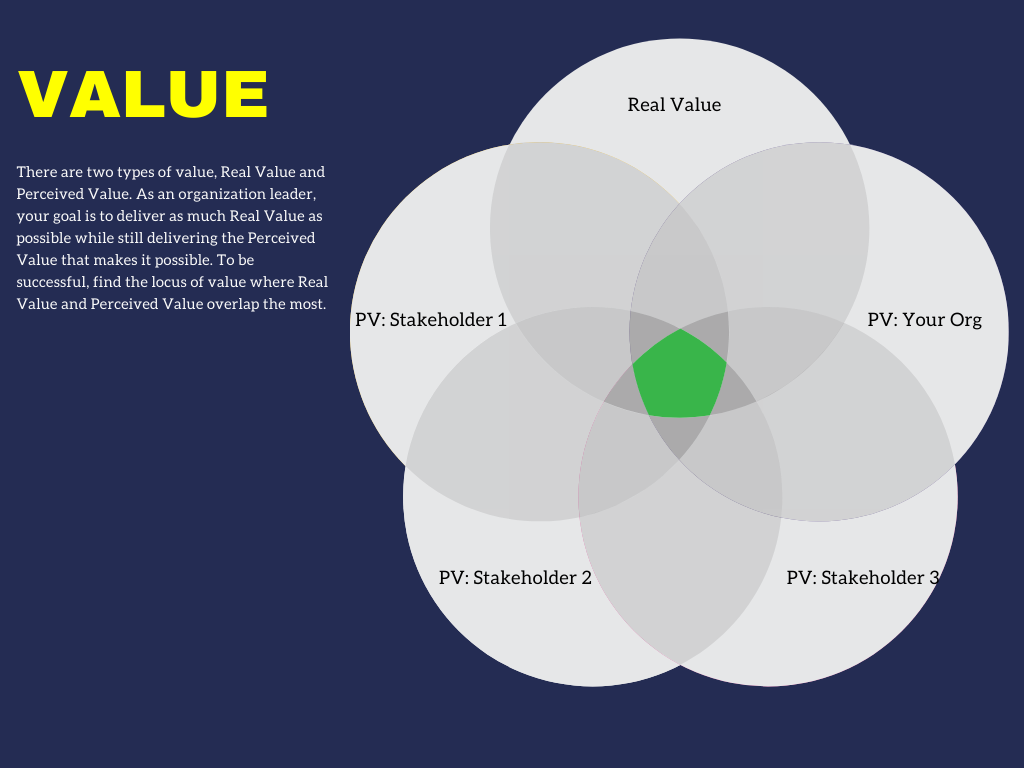The Economy of Political Capital
Understanding the ebb and flow of Political Capital will make you more successful in delivering Real Value for your organization.

In one of my roles, I worked for a very profitable company. They saw an excellent month over month growth in the number of clients and revenue. In the particular industry that this company was a part of, it was common to reimburse customers for downtime. Unfortunately, it fell over quite a lot. The payments that the company made to clients ramped up into a low double-digit percentage of overall revenue.
The company started out selling 'shrink-wrapped' software for on-prem installment. To increase business, they moved that software to the cloud and started selling it as a service.
That monolithic system had many problems. It had hard upper limits on the number of concurrent users. It couldn't scale horizontally, and it fell over all the time. The optics around the problem were terrible both inside and outside the company. They hired a new CTO and gave that CTO the mandate to fix the problem. That new CTO launched a project to do a ground-up rewrite of the system. He pitched that rewrite to the CEO, the board of directors, and the engineering team of about a hundred people. He then assigned the entire engineering team to the new product, leaving the existing product unmaintained and unsupported. Shortly after this refocus, I came in to take over the project and everyone working on it.
When I arrived, the teams were foundering, trying to figure out what to do. There was no architecture. The organization hadn't given any thought to how to structure the project so that multiple teams could work on it. There wasn't a definition of the minimal viable product. On top of all that, the existing system had started to suffer. The downtime was increasing along with the repayment rate to customers. Features that customers where demanding where not getting implemented. It was a mess.
One of the first things I did was carve out a small, senior team to work on the new product and re-tasked the rest of the organization to maintain and develop the existing, profitable system. Overall, ninety people went back to the jobs they knew, supporting the company while about ten or so focused on the new project. The primary system stabilized while we made significant progress on the new system. From the perspective of Real Value provided to the company, it was a significant win, but doing that cost me a tremendous amount of Political Capital and made later changes and improvements much harder. Unknowingly, I expended an enormous amount of Political Capital on an endeavor that provided no return on that capital. I then lacked the Political Capital to make investments in future beneficial changes.
The Right Thing Isn't Always Obvious
How did that happen? The new CTO had pitched the rewrite as the only way to fix the problem. He had spent significant time and capital getting the project green-lit. He had pitched it to the engineering team as the future of the company. Everyone involved believed that this project would save the company. They also thought that if they were not working on the project, they would lose influence or be out of a job in the long run. I had unknowingly undermined the CTO, put everyone into dead-end positions, and prolonged the companies suffering. That wasn't true, but that is how the organization perceived it at the time. The fact that ground-up rewrites seldom work, the company had an existing working, revenue-generating system, and the engineering teams where foundering before we shifted back to a production role didn't matter.
At some point, after we had gotten things moving again, we finished the MVP and started trying to find target customers to shift to the new platform. We got push-back from the business. They wanted the new product had to function exactly like the existing product, down to the UI bugs that the current product contained. The business had a deeply embedded fear that the company would lose customers if the customers had to do any training. They hadn't articulated this until we went and requested to shift customers to the new product. We discovered that the business side had an aversion to risk that made the new product non-viable. If I had built my Political Capital I might have been able to move the product forward. However, I exhausted my capital, by forcing the organization onto the 'right' track, and got no return on that investment. That left me with no capital spend on moving the project forward when we ran into problems. One of my last acts before leaving the company was shuttering the project and dedicating the resources back to the existing, profitable system.
Political Capital Enables Goals
Success for your organization requires that you deliver on your goals. Three things drive your ability to accomplish a goal.
- How much Political Capital will it cost to drive the goal
- How much Political Capital do you have to invest in that goal
- How much return on Capital will you get from delivering on that goal
The amount of Political Capital returned does not depend on the Real Value of the goal. It depends on the Perceived Value. In other words, it depends on how valuable a particular stakeholder perceives it to be. The Perceived and Real Value may align, but they probably don't. Your job as a leader is to produce as much Real Value as possible. To be successful, you also need to deliver Perceived Value as well. You must manage Political Capital as a resource that you gain by delivering things that have Perceived Value to deliver Real Value to the organization.
In a perfect world, Perceived and Real Value always align. In that world, your stakeholders are logical and insightful. They have the organization's best interest at heart and understand when you need to deliver something for a different stakeholder. That organization is happy, fully aligned, and sees the Real Value in the work they produce. That organization doesn't exist. Even in the best organizations, with the best people, never align Real and Perceived Value completely. There is always a dichotomy. Since the perceiver judges Perceived Value, there isn't any standard for that value across your stakeholders. One stakeholder will see a high Perceived Value in something you deliver while another stakeholder won't.
The key to success is subtly balancing the schedule to deliver enough Perceived Value to allow you to deliver the Real Value. Deciding the order of that schedule can be complicated. You have to weigh the relative Perceived Value to each stakeholder and optimize the value delivery where you need to increase your Political Capital.

In weighing where to invest your organization's time, you must look to the things that provide Real Value and overlap with your stakeholder's Perceived Value. The more they overlap, the better off you are. Where there isn't a lot of overlap across the board, choose the stakeholder that most enables you to deliver Real Value. Be careful about how you judge your stakeholders. It's natural to identify people that you like the most, or that you are attracted to, or the one that goes out for beers with you as the stakeholder that provides the most return on Capital. However, you are probably not that lucky.
Find the stakeholder that most enables you to deliver Real Value. That stakeholder is dynamic depending on what you need and who has influence and is willing to use it. For example, let's say you have a stakeholder who usually isn't valuable to the organization and understands that fact and isn't bothered by it. In this instance, they are getting a lot of pressure and need something from you. They also have the ear of high-value stakeholders. That may make them a high-value stakeholder for a time. It's a dynamic situation, and that you need to always be on top of it.
Never forget that your most important stakeholder is your organization. While you may, in theory, order them to do something and get it done. The reality is not so black and white. The more your team wants to do something and the more valuable they think that something is, the more engaged they will be. They will do a better job they will do, and they will be happier doing it. The Political Capital you carry with your organization is the most critical Political Capital that you have.
Managing Capital

Building Capital
You enter an organization with a certain amount of Political Capital when they hire you. The amount depends on several factors, including how well known you were to the organization before they hired you and how much need there is for the skills that you have in the organization. That Political Capital is your nest egg. You invest that nest egg in things that deliver on perceived value.
Assessing Perceived Value
To know where to invest, you have to understand what you have to gain. To assess Perceived Value, you must know both who your stakeholders are and where their pain is. If one of your stakeholders would like a new feature, that's one level of Perceived Value. If that feature increases the revenue for their organization or decreases cost, it increases Perceived Value. If that feature increases their Political Capital, then the Perceived Value is even higher.
If you don't have a sense of the return on Capital of a work item and how that varies from item to item, you can't prioritize well. The mind of the perceiver defines the Perceived Value. You can not estimate the Perceived Value reasonably without knowing that mind. You must know your stakeholders well and engage with them deeply and regularly.
Aligning Perceived and Real Value
Never lose sight of the fact that your ultimate goal is to deliver Real Value for your company. Delivering Perceived Value is a means to an end. With that in mind, it makes sense for you to try to align Perceived Value and Real Value as much as possible. For a stakeholder to perceive value in a unit of work, it has to benefit them somehow. In the technology world, that benefit may not be immediately apparent. You need to make that evident by selling the work as something that is going to benefit them. Convince them of the result's value so that the Real Value of that work has a higher Perceived Value to that stakeholder. Of course, only do that if it's true. In general, lying is a great way to destroy your Political Capital with your stakeholders. Avoid it at all costs.
Maximizing Returns
You can increase the Perceived Value of the same work by unexpectedly supplying additional value. If you recognize the old trope 'Under promise, over deliver.', you aren't wrong. It is an old trope because it works so well. If one of your stakeholders is in a tight time crunch and you can deliver a few days early, giving that stakeholder a couple of days of wiggle room can massively increase the return in Capital. Providing features that are 'better' in some way then what you agreed to with your stakeholder also increases the Perceived Value of that work. Be always on the lookout for these opportunities. Be careful though, these 'wins' generally come from good planning, estimation, and focus rather than last-minute crunches.
Minimizing Loss
Inevitably, there will come a time when you are not able to deliver something on time. That is going to cost you Capital. The key to minimizing your Capital loss is being transparent and informing the stakeholder as early as possible. It is always tempting, especially in politically charged environments, to wait and try to 'save' things. You think to yourself, 'We still have time, we can still make it happen,' even when you know the likelihood of success is very low. Once it's probable that you won't make the deadline and you have enough information to set a new deadline, reach out to your stakeholder and let them know. They won't be happy if you tell them the month before the deadline that you won't be delivering, but it will be much worse if you tell them the day before.
Capturing Returns
Once you have delivered a unit of work, celebrate that unit of work, update the stakeholders who perceive value in that work. Measure the value of that work metrics, review those metrics, and review those metrics with your stakeholders from time to time. People have a relatively short memory, helping them remember the value your organization has and continues to provide enables you to capture and retain Political Capital. Be careful here. This celebration and review have to feel natural to both them and you. Otherwise, you run the of squandering your Capital. The natural points are when you deliver a unit of work or when the metrics around a unit of work change significantly.
Drawing on Capital
You draw on the capital is implicit. You draw on capital when you can't deliver on time. You draw on capital when focus on delivering something that does not provide Perceived Value to your stakeholder at the expense of something that does. That drawing on capital should almost never be explicit. Only in the most extreme cases should you say to your stakeholder 'do you remember all these great things I delivered for you in the last few months, you have to cut us some slack'. That is, very much a last resort. That transaction is implicit.
Finally
Your goal as a leader is to always produce Real Value for the organization. However, focusing exclusively on high Real Value, but low Perceived Value is a very seductive trap. Be aware of the Perceived Value produced and use that as one of the essential metrics that drive how you schedule the work. If you do this well, you will have the Political Capital to draw on when you need it. If you don't, you won't have it when you need it and will end up bankrupt.



